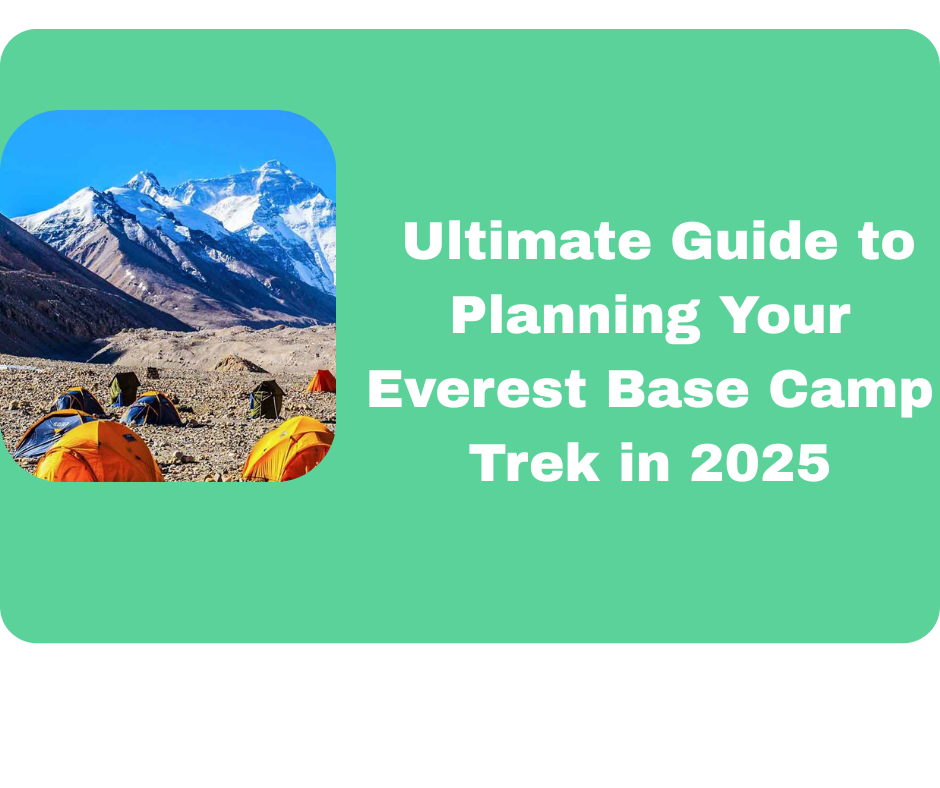Ultimate Guide to Planning Your Everest Base Camp Trek in 2025 If standing at the foot of the world’s highest peak is on your bucket list, the Everest Base Camp trek offers a life-changing experience. But to make the journey smooth and memorable, smart planning is essential. This guide will walk you through everything you need—from preparation to the actual trek.
Why Sherpas Are the Ultimate Guides to Climbing Mount Everest ?
1. Why Choose Everest Base Camp Trek?
The Everest Base Camp (EBC) trek isn’t just about seeing Mt. Everest. It’s a walk through ancient Sherpa villages, Buddhist monasteries, high-altitude landscapes, and icy glaciers. You'll also witness the daily life of locals who call the Himalayas their home.
2. Best Time to Visit Everest Base Camp
The ideal seasons are:
Spring (March to May) – Clear skies, blooming rhododendrons, great views.
Autumn (September to November) – Best weather with high visibility and stable conditions.
Avoid monsoon and winter unless you're an experienced hiker.
3. What to Pack for the Everest Base Camp Trek
Packing right is crucial. Here’s a basic checklist:
Layered clothing (base, insulation, waterproof)
Trekking boots
Warm gloves, beanie, sunglasses
Sleeping bag (-10°C rating)
First-aid kit and personal meds
Water purification tablets
Power bank and headlamp
4. Planning Your Itinerary – Days and Route
A typical EBC itinerary spans 12-14 days:
Day 1: Fly from Kathmandu to Lukla
Day 2-3: Trek to Namche Bazaar (Acclimatization day)
Day 4-6: Trek through Tengboche and Dingboche
Day 7-8: Reach Lobuche and Gorakshep
Day 9: Trek to Everest Base Camp and return to Gorakshep
Day 10-12: Return trek to Lukla
5. How to Physically Prepare for the Trek
Everest Base Camp is not a technical climb, but it is physically demanding. Start training 2-3 months before
Focus on cardio, strength training, and stamina
Try hiking with a loaded backpack
6. Dealing with Altitude Sickness
Acclimatization is key. Walk slowly, drink plenty of water, and never skip rest days. Know symptoms like headaches, dizziness, or nausea.
Pro Tip: Carry Diamox (altitude sickness pill) with a doctor's prescription.
7. Accommodation and Food on the Trail
Expect basic teahouses and lodges. Most offer: Twin bedrooms
Hot meals like dal bhat, noodles, porridge
Paid Wi-Fi and hot showers
8. Cost Breakdown of Everest Base Camp Trek
Here’s an estimate per person: Trekking permits: ~$50
Flights (Kathmandu–Lukla): ~$150–$200
Accommodation: ~$5–$15 per night
Meals: ~$15–$25 per day
Guide/Porter: ~$25–$30/day (optional but helpful)
Total for 14 days: $1000–$1500
In Nepali Rupees multiply it by 134
9. Permits and Documents Needed
You’ll need:
TIMS Card (Trekkers’ Information Management System)
Sagarmatha National Park Permit
Khumbu Rural Municipality Permit
Carry 4 passport-size photos and a valid passport copy.
10. Travel Insurance for Everest Trek
You must have insurance that covers:
Trekking up to 6,000m
Emergency evacuation (helicopter rescue)
Trip cancellation or delays
11. Should You Hire a Guide or Go Solo?
While solo trekking is allowed, a licensed guide helps with: Route navigation
Acclimatization
Cultural insights
Emergency support
You can also hire porters to carry your bag.
12. Essential Tips from Local Trekkers
Always carry cash; ATMs are rare.
Respect local culture—no loud music, modest dress.
Bring a reusable water bottle and purifiers to avoid plastic.
Power banks are your best friend—charging costs extra.
Final Words: Trek with a Purpose, Return with a Story Reaching Everest Base Camp is a dream for many and a reality for those who plan wisely. Whether you're going for the adventure, the spiritual peace, or just to say "I did it", every step is worth it.
Fun Facts: What You’ll See Along the Way on the Everest Base Camp Trek
Your Everest Base Camp journey isn’t just about reaching high altitudes—it's also a deep dive into breathtaking landscapes and Himalayan wildlife. Here are some interesting and fun facts about what you’ll experience visually and naturally:
1. Jaw-Dropping Scenery at Every Turn
You’ll walk beneath the shadows of towering peaks like:
Lhotse, Choyu,** Makalu **and of course, Mount Everest (8,848.86m)
The Khumbu Glacier and **Icefall **near Base Camp look like something out of a sci-fi movie.
Suspension bridges hanging above roaring rivers make for thrilling crossings.
Sunrise from Kala Patthar (5,644m) is arguably the best view of Everest—not from the summit, but from a safe, accessible ridge.
2. Unique Landscapes
The trek begins in lush green valleys filled with pine and **rhododendron **forests.
Gradually, the landscape transforms into alpine meadows, rocky ridges, and snowfields.
In spring (March–May), the trails light up with blooming rhododendrons—Nepal’s national flower.
3. Himalayan Wildlife You Might Spot
Himalayan Tahr – a wild goat with a thick reddish-brown coat.
Danphe (Lophophorus) – Nepal’s colorful national bird, especially visible in spring.
Local mountain dogs – often seen trotting alongside trekkers or lazing near teahouses.
** Pikas and marmots** – small mountain mammals that whistle to warn of danger.
Rare but possible sightings: snow leopards, red pandas, and musk deer in the higher altitudes, especially in protected zones.
4. Cultural Sights Along the Trail
Tengboche Monastery – the largest monastery in the Khumbu region, with prayer flags fluttering in the wind.
Mani stones, prayer wheels, and stupas dot the trail, adding a spiritual charm.
**Friendly Sherpa **villages like Namche Bazaar and Dingboche welcome you with hospitality and warm tea.
Pro Tip: Bring a Camera or Binoculars
The best part? You don’t need to be a professional photographer to capture beauty here—every view is picture-perfect. Don’t forget to look up at night too; the stars are incredibly bright, especially above 4,000m.
